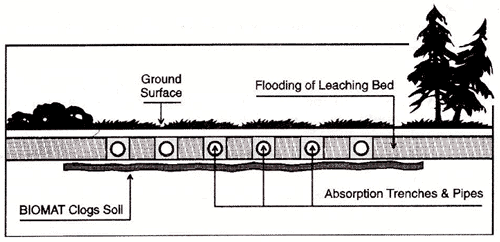
The Township Building Department reviews septic/sewage system permits and regulation for sewage system permits up to the flow rate of 10,000L/D.
The Leeds, Grenville and Lanark District Health Unit ceased accepting applications September 30, 2022. Permits issued by the Health Unit prior to this date will be overseen to completion by the Health Unit.
When is a sewage application/maintenance inspection required?
| New Construction |
|
| Renovations to Dwellings |
|
Renovations to existing dwellings may reduce the performance level of the sewage system in the following situations:
If any of the above applies and the results show that the daily design sewage flow of the dwelling exceeds the capacity of the sewage system components, then the system must be upgraded to accommodate the increased flow rate. Other structures, including garages (attached or detached), swimming pools or buildings that may reduce the performance level due to its proximity to the sewage system, are also included in the requirements for an application if it is within a 15 metre distance. |
| Commercial/Industrial New Construction or Renovation |
| For any system up to 10,000 litres per day, a review by the Township will be required to determine if a new system or maintenance inspection is required. For any system proposed at 10,000 litres or above will require approval from the Ministry of the Environment, Conservation and Parks. Pre-consultation through the Development Review Team is encouraged prior to the submission of a sewage system or building permit application. |
| Home Based Business/Commercial Kitchen/Bed and Breakfast |
| The creation of a home based business may require the submission of a sewage system maintenance application depending upon the nature of the business. The creation of a commercial kitchen and a bed and breakfast will require a maintenance inspection to ensure the existing sewage system will accommodate the additional usage. Upgrades to a sewage system may be required based on the outcome of the maintenance inspection should the system be found to not be operating according to design. |
| Consent (Severance) Applications (New Lot Creations and Lot Additions) |
| An application for the creation of a new lot will require a sewage system maintenance inspection. A lot addition may also require a review of any existing or proposed sewage disposal systems if there is the potential for impact on the system. Staff will review the proposal to determine if there is an acceptable location for a new sewage system on a property for new lot creations. |
| Township Planning Applications |
|
The submission of a planning application may require a sewage system maintenance inspection to determine if your system is sized accordingly for the new development and that the new development meets the required setbacks to any existing sewage system. Pre-Consultation through the Township's Development Review Team process is encouraged to determine if a sewage system maintenance inspection is required prior to the submission of a planning application. The various types of planning applications that may require review include but are not limited to:
|
When is a septic application/maintenance inspection not required?
| Properties in the Village of Lansdowne |
| Properties within the Village of Lansdowne are on Municipal Water and Sewer. Approval for new dwelling construction is required through the Ontario Clean Water Agency (OCWA). Renovations to dwellings or businesses may require OCWA approval. Please visit their website for further information. |
Application and Maintenance Forms
| Sewage System Application Forms |
|
Class 1 - A chemical toilet, an incinerating toilet, a recirculating toilet, a self-contained portable toilet and all forms of privy including a portable privy, an earth pit privy, a pail privy, a privy vault and a composting toilet system. A sewage system permit is not required for these systems, however approval from the Township's Planning Department is required. Please submit a detailed plot plan demonstrating the proposed location of the system to the Building Department for review prior to construction or installation. Approval from other agencies such as the Cataraqui Region Conservation Authority, St Lawrence Parks Commission and the Ministry of Transportation may be required. |
| Maintenance Inspection Forms |
|
Class 2 Maintenance Form - A class 2 sewage system can only be used for the treatment and disposal of greywater (non-human body waste) i.e., kitchen sink wastes, bathtubs, washing machines, etc. This type of system is ONLY adequate to treat small amounts of greywater (less than 1000 litres per day) for premises such as cottages and hunt camps, etc. |
Other Agency Approvals Required
In addition to the Township, other agency approvals may be required prior to the issuance of a building permit for a sewage system.
| Cataraqui Region Conservation Authority |
|
Approval from the Cataraqui Region Conservation Authority (CRCA) may be required if the existing or proposed sewage system is within 50 metres of a watercourse or waterbody, 50 metres of a Locally Significant Wetland (LSW) or Area of Natural and Scientific Interest (ANSI), 120 metres to a Provincially Significant Wetland (PSW) and within 200 metres of a Species of Risk (SR) area. All applications are forwarded to the CRCA for review as there are other factors that may affect their office's approval. |
| St Lawrence Parks Commission |
| If the property is adjacent to, or within the controlled area, of the 1000 Islands Parkway, approval from the St Lawrence Parks Commission may be required. Please visit their website for further information. All applications are forwarded to the St Lawrence Parks Commission for review as there are other factors that may affect their office's approval. |
| Ministry of Transportation |
| If your property is adjacent or within the controlled area of a Provincial Highway approval from their office is required. Please visit their website for further information. All applications are forwarded to the Ministry of Transportation for review as there are other factors that may affect their office's approval. |
What Are the Required Clearance Distances for Class 1, 2 and 3 Sewage Systems?
| Class 1 - Earth Pit Privy (Outhouse) |
|
Please contact the Building Department for information required for setbacks. |
| Class 1 - Privy Vault, Pail Privy |
|
| Class 2 - Grey, Water System |
|
| Class 3 - Cesspool |
|
What Are the Required Clearance Distances for a Class 4 or 5 Sewage System?
| Class 4 - Minimum Clearances for Treatment Units |
|
| Class 4 - Minimum Clearances for Distribution Piping |
|
| Class 5 - Minimum Clearances for Holding Tank |
|
What Steps Can I Take to Ensure My Septic System Functions Properly
A sewage system which has been properly installed, should, with proper care and maintenance provide many years of service. There are, however, some things which individuals need to be aware of which will help the system function properly.
| Step 1 - Avoid Putting the following into a septic system |
|
| Step 2 - Avoid directing the following water into a septic system |
|
| Step 3 - Avoid Discharge Water unless system is designed for it |
| Discharge water from softeners and iron filters should not be directed into the sewage system unless the system has been designed to accept such discharges. |
| Step 4 - Keep water usage to a minimum |
| Water usage in the home should be kept to a minimum. Excessive use, such as doing numerous loads of laundry in one day, could flush solids from the treatment unit (septic tank) into the leaching bed. |
| Step 5 - No need for starters, bacterial feeds or cleaners |
| There should be no need to use “starters”, “bacterial feeds” or “cleaners”. |
| Step 6 - Conduct Regular Inspections |
|
The treatment unit should be inspected at regular intervals and pumped out whenever sludge and scum occupy 1/3 of the working capacity of the tank. Septic tanks contain deadly gases and should only be inspected by firms specializing in this work. |
| Step 7 - Avoid Vehicular Traffic |
|
Vehicular traffic (including snowmobiles) should not be allowed over the tank and leaching bed. |
| Step 8 - Encourage grass and avoid shrubs, flowers, gardens and trees in the leaching area |
| The area over a leaching bed should have a good cover of grass allowing for adequate sunlight and ventilation to be maintained. Avoid planting shrubs, flowers, gardens and trees over this area. |
How do I know if my Septic System is having Problems?
| Diagram of Sanitary Sewage in Foundation |
|
This diagram depicts sanitary sewage effluent that is being picked up in the perimeter weeping tile surrounding the house and is being drained into the internal sump pit in the building. This may indicate a break in the pipe between the building and the tank, which would cause the sanitary sewage to leak into the foundation backfill and into the weeping tile. |
| Diagram of Blockage in Inlet Pipe |
|
A cause of sanitary sewage backup into a building is blockage of the pipes in the sanitary sewage system. If the sewage is backing up into the building the septic tank must be opened and examined. If the liquid level in the tank is below the level of the inlet pipe then there is a blockage between the building and the inlet of the tank. A plumbing contractor can remove this type of blockage using a plumbing snake. |
| Diagram of Blockage in Outlet Pipe |
|
If the level of sanitary sewage in the tank is above the inlet pipe, the blockage is on the outlet side of the tank and may be in the tile bed. A high level of sewage within the tank could also indicate that the entire leaching bed is saturated and that the ground can no longer absorb the liquid. |
| Diagram of Bio Mat |
|
The saturation of a leaching bed is one of the most serious causes of malfunction of a septic system. Saturation occurs when the receiving soil surrounding the leaching bed cannot accept any more effluent. Blockage is usually caused by clogging of the soil by the Biomat which is created under the tile trench. |













